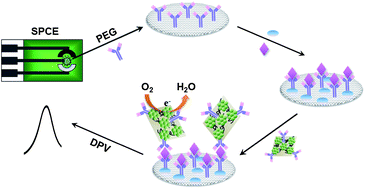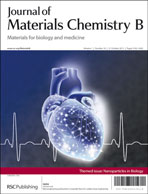An ultrasensitive immunosensing method was developed using platinum nanodendrite functionalized graphene nanosheets (PtNDs@GS) as a non-enzymatic label for the electrochemical detection of human immunoglobulin G (HIgG). The PtNDs@GS hybrid was prepared in situ by reducing K2PtCl4 with ascorbic acid in an aqueous solution of reduced graphene oxide, and characterized by scanning electron microscopy, transmission electron microscopy and spectral techniques. The disposable immunosensor was constructed by coating a polyethylene glycol film on a screen-printed carbon working electrode and then immobilizing the capture antibody on the film. After binding with the antigen for further capture of the PtNDs@GS labelled antibody, PtNDs@GS was introduced as an electrochemical tag to produce a large electrocatalytic current towards the reduction of dissolved oxygen for signal amplification. Compared with the enzyme-based immunosensor, PtNDs@GS as non-enzymatic tag exhibited many advantages. This method showed a good linearity in the concentration range of 1 pg mL−1 to 10 ng mL−1, with a detection limit of 0.87 pg mL−1. PtNDs@GS as non-enzymatic label provides a versatile method for constructing ultrasensitive immunosensors, and demonstrates proof-of-concept in immunosensing.

You have access to this article
 Please wait while we load your content...
Something went wrong. Try again?
Please wait while we load your content...
Something went wrong. Try again?


 Please wait while we load your content...
Please wait while we load your content...